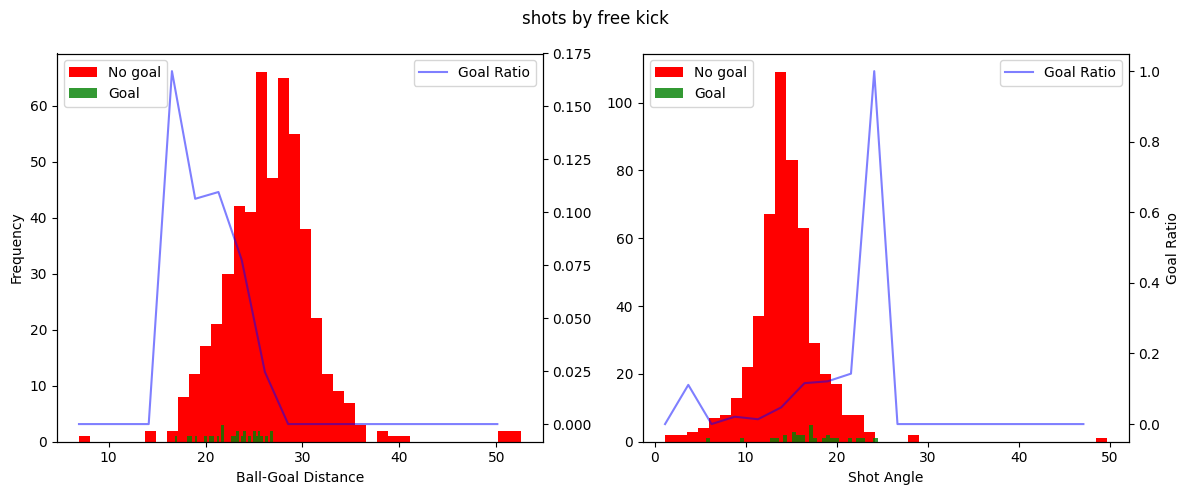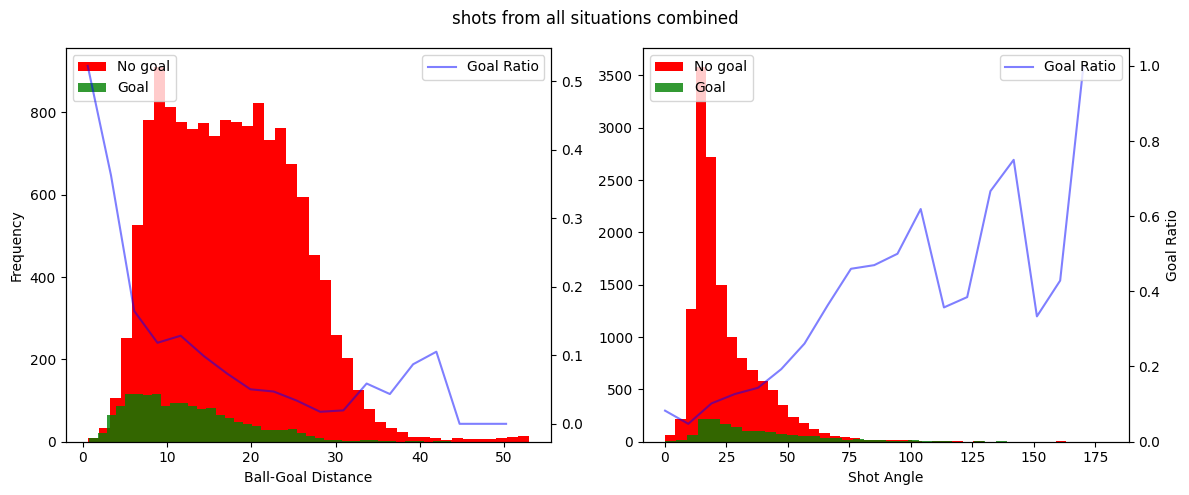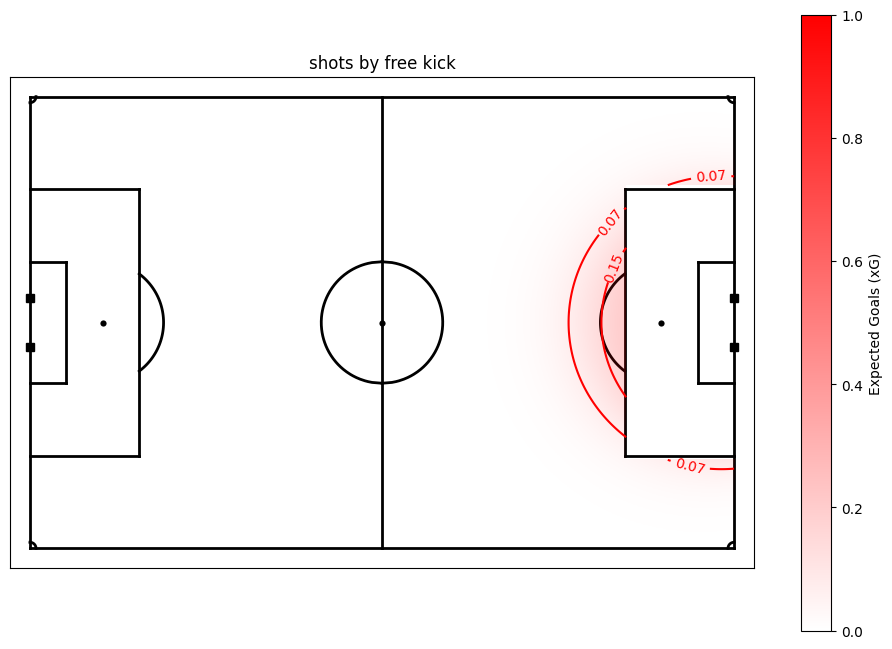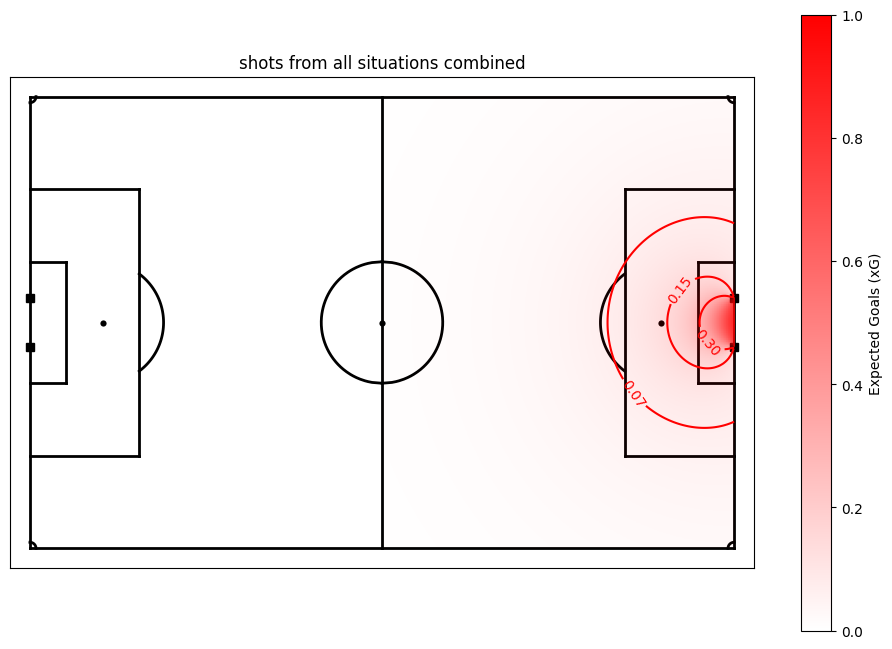Expected Goals (xG)
This is a notebook that creates some simple xG models for the DataBallPy package. xG is a metric to evaluate the probability that a shot, given some characteristics of that shot, will turn out to be a goal. xG has been highly debated and discussed and is used increasingly in practice. Their is a lot of information about expected goals, but if you want to read more, I highly recommend the blog posts from the KU Leuven:
Although we do have tracking data which provides us with the possibility to create a rather complex xG model, in this notebook we decided to keep things rather simple for two reasons: (1) The added performance xG models that use tracking data is low compared to xG models that do not use tracking data related features, and (2) keeping the model simple makes it easier to interpretet the model. Lets get started!
import pandas as pd
import numpy as np
import matplotlib.pyplot as plt
from matplotlib.colors import LinearSegmentedColormap
from copy import deepcopy
from sklearn.linear_model import LogisticRegression
from sklearn.model_selection import train_test_split
from sklearn.preprocessing import StandardScaler, FunctionTransformer
from sklearn.metrics import brier_score_loss
from sklearn.pipeline import Pipeline
import joblib
from databallpy.features.angle import get_smallest_angle
from databallpy.visualize import plot_soccer_pitch
data = pd.read_csv("../data/shot_features.csv", index_col="Unnamed: 0")
data["shot_outcome"] = data["shot_outcome"].apply(lambda x: 1 if x=="goal" else 0)
Data preprocessing
# delete all shots from own half, probably an error in the data
data = data[data["ball_goal_distance"] <= 53].copy()
# create single column that indicates whether the shot was taken by foot or not
data["is_by_foot"] = data["body_part"].apply(lambda x: 1 if "foot" in x else 0)
data.drop(columns=["body_part"], inplace=True)
# For this model, we are really only interested in the shot distance and the shot angle
data = data[["ball_goal_distance", "shot_angle", "is_by_foot", "type_of_play", "shot_outcome"]].copy()
print(data["shot_outcome"].value_counts())
print(data.info())
print(data.describe())
shot_outcome
0 14138
1 1706
Name: count, dtype: int64
<class 'pandas.core.frame.DataFrame'>
Index: 15844 entries, 0 to 41
Data columns (total 5 columns):
# Column Non-Null Count Dtype
--- ------ -------------- -----
0 ball_goal_distance 15844 non-null float64
1 shot_angle 15844 non-null float64
2 is_by_foot 15844 non-null int64
3 type_of_play 15844 non-null object
4 shot_outcome 15844 non-null int64
dtypes: float64(2), int64(2), object(1)
memory usage: 742.7+ KB
None
ball_goal_distance shot_angle is_by_foot shot_outcome
count 15844.000000 15844.000000 15844.000000 15844.000000
mean 17.069520 26.114796 0.819111 0.107675
std 7.794867 16.745407 0.384938 0.309979
min 0.600167 0.022857 0.000000 0.000000
25% 10.637804 15.295443 1.000000 0.000000
50% 16.491207 20.207843 1.000000 0.000000
75% 22.738823 32.808210 1.000000 0.000000
max 52.992204 179.654562 1.000000 1.000000
Looking at the data, we have a total of 15844 shots, of which 1706 are actual goals (10.8%). Our baseline model would just assume that every shot has a 10.8% chance of being a goal, but I think we can do better. The next step is creating different datasets for different types of shots. In open play, you either shoot by foot, or with an header (roughly speaking). Second, we also have set pieces. For penalties, we know that all features (distance to goal and shot angle) are equal, so the xG of a penalty is just the success rate of all penalties in our dataset. For free kicks, the distance and goal angle is variable, therefore we will also create a model for free kicks specifically. Last, we will create a xG for all shots, to evaluate if the different types of shots actually are different in terms of xG or not.
open_play_data = data[data["type_of_play"].isin(["regular_play", "corner_kick", "crossed_free_kick", "counter_attack"])]
free_kick_data = data[data["type_of_play"]=="free_kick"]
penalty_data = data[data["type_of_play"]=="penalty"]
foot_data = open_play_data[open_play_data["is_by_foot"] == 1]
header_data = open_play_data[open_play_data["is_by_foot"] == 0]
all_datasets = [foot_data, header_data, free_kick_data]
all_shots = pd.concat(all_datasets)
all_datasets.append(all_shots)
titles = ["shots by foot", "shots by header", "shots by free kick", "shots from all situations combined"]
print(f"The xG of a penalty in our dataset is {round(len(penalty_data[penalty_data["shot_outcome"]==1]) / len(penalty_data), 3)}\n")
for data, title in zip (all_datasets, titles):
n_goals = len(data[data["shot_outcome"]==1])
print(f"We have {len(data)} {title}, of which {n_goals} is a goal ({round(n_goals*100/len(data), 1)}%).")
The xG of a penalty in our dataset is 0.792
We have 12322 shots by foot, of which 1281 is a goal (10.4%).
We have 2866 shots by header, of which 302 is a goal (10.5%).
We have 536 shots by free kick, of which 28 is a goal (5.2%).
We have 15724 shots from all situations combined, of which 1611 is a goal (10.2%).
The percentage goals for the in play subsets seems to be relatively stable. For the free kicks here is a lower percentage of goals scored. Also note that the total shots and goals has decreased slightly since we excluded the penalties. However, this is still very describtive, lets look at the relation between the features and the goals scored.
Data exploration
def get_shot_angle(x:float, y:float) -> float:
"""Given a x, y coordinate, calculates the angle in degrees between
the vector from the ball to the left post and the vector form the ball
to the right post."""
ball_xy = np.array([x, y])
left_post_xy = np.array([53, 3.66])
right_post_xy = np.array([53, -3.66])
ball_left_post_vector = left_post_xy - ball_xy
ball_right_post_vector = right_post_xy - ball_xy
angle = get_smallest_angle(
ball_left_post_vector, ball_right_post_vector, angle_format="degree"
)
return angle
left_post_xy = np.array([53, 3.66])
right_post_xy = np.array([53, -3.66])
x_locs = [53-16.5, 52-24, 53-3, 53-9]
y_locs = [12, 0, -10, -30]
fig, ax = plot_soccer_pitch()
ax.scatter(x_locs, y_locs, label="shot location", color="black", s=90)
n = 1
for x, y in zip(x_locs, y_locs):
ax.plot([x, left_post_xy[0]], [y, left_post_xy[1]], color="orange", alpha=0.8, zorder=-.05)
ax.plot([x, right_post_xy[0]], [y, right_post_xy[1]], color="orange", alpha=0.8, zorder=-.05)
ax.text(x, y-0.15, str(n), color="white", fontsize=10, ha="center", va="center")
n += 1
shot_angle = get_shot_angle(x, y)
distance = np.sqrt((x-53)**2 + y**2)
angle_text = f"shot angle: ${shot_angle:.1f}^{{\\circ}}$"
distance_text = f"shot distance: {distance:.1f} m"
ax.text(x-10, y + 1, angle_text, color="black", fontsize=10, ha="center", va="center")
ax.text(x-10, y - 1.3, distance_text, color="black", fontsize=10, ha="center", va="center")
ax.legend(loc= "upper center")
plt.show()

Before really going into the data exploration, it is good to talk about what the features actually mean. The distance is the distance of the ball till the center of the goal in meters. The angle is the angle between two vectors: (1) the vector between the shot location and the right post, and (2) the vector between the shot location and the left post. The shot angle is therefore a function of the distance to the goal and the angle with the goal. For instance, the shot angle for shot 1 and 2 are almost equal, but shot 1 is closer to the goal, however, it is also moved out to the side more. Shot 3 and 4 are perfectly aligned between each other, but shot 4 has an angle of 4 degrees and shot 3 of 13 degrees. This is of course because the distance to the goal is a lot higher for shot 4 compared to shot 3.
Now that you have a feel for the features we use, lets look at how they relate with goal scoring probabilities.
for data, title in zip(all_datasets, titles):
fig, (ax1, ax3) = plt.subplots(1, 2, figsize=(12, 5))
# distances
bins_distances = np.linspace(data["ball_goal_distance"].min(), data["ball_goal_distance"].max(), 20)
hist_goals_dist= np.histogram(data.loc[data["shot_outcome"]==1, "ball_goal_distance"], bins=bins_distances)[0]
hist_total_dist = np.clip(np.histogram(data["ball_goal_distance"], bins=bins_distances)[0], a_min=1e-5, a_max=None)
percentage_goals_distances = hist_goals_dist / hist_total_dist
ax1.hist(data.loc[data["shot_outcome"]==0, "ball_goal_distance"], bins=40, color="red", label="No goal")
ax1.hist(data.loc[data["shot_outcome"]==1, "ball_goal_distance"], bins=40, color="green", alpha=0.8, label="Goal")
ax1.set_xlabel('Ball-Goal Distance')
ax1.set_ylabel('Frequency')
ax2 = ax1.twinx()
ax2.plot(bins_distances[:-1], percentage_goals_distances, color="blue", label="Goal Ratio", alpha=0.5)
ax1.legend(loc="upper left")
ax2.legend(loc="upper right")
# angles
bins_angles = np.linspace(data["shot_angle"].min(), data["shot_angle"].max(), 20)
hist_goals_angles = np.histogram(data.loc[data["shot_outcome"]==1, "shot_angle"], bins=bins_angles)[0]
hist_total_angles = np.clip(np.histogram(data["shot_angle"], bins=bins_angles)[0], a_min=1e-5, a_max=None)
percentage_goals_angles = hist_goals_angles / hist_total_angles
ax3.hist(data.loc[data["shot_outcome"]==0, "shot_angle"], bins=40, color="red", label="No goal")
ax3.hist(data.loc[data["shot_outcome"]==1, "shot_angle"], bins=40, color="green", alpha=0.8, label="Goal")
ax3.set_xlabel('Shot Angle')
ax4 = ax3.twinx()
ax4.plot(bins_angles[:-1], percentage_goals_angles, color="blue", label="Goal Ratio", alpha=0.5)
ax4.set_ylabel("Goal Ratio")
ax3.legend(loc="upper left")
ax4.legend(loc="upper right")
fig.suptitle(title)
fig.tight_layout()
plt.show()




This is very interesting! We can clearly see a few things. Firstly, for the shot distance you can see an exponentional decreasing ratio of shots being scored as the distance to the shot to the goal increases. Secondly, there seems to be a linear increase in the ratio of shots being scored with the increase of the shot angle. It seems that these variables do indeed hold information about whether a shot is going to be a goal or not. You can also clearly see that the goal ratio values become more and more random as we have less samples, for instance when shots are taken from more than 30 meters or in general in the free kick data.
Building the xG models
We will build the expected goal models for every type of shot. For this we will simply use a logistic regression since it is easiest to interpretet.
models = {}
scalers = {}
random_state=42
for data, title in zip(all_datasets, titles):
y = data["shot_outcome"].copy().astype("category")
X = data[["ball_goal_distance", "shot_angle"]].copy()
X_train, X_test, y_train, y_test = train_test_split(X, y, test_size=0.2, stratify=y, random_state=random_state)
scaler = StandardScaler()
X_preprocessed = scaler.fit_transform(X_train.values)
scalers[title] = scaler
logistic_reg = LogisticRegression(solver="liblinear")
logistic_reg.fit(X_preprocessed, y_train)
models[title] = logistic_reg
X_test_preprocessed = scaler.transform(X_test.values)
y_pred_proba = logistic_reg.predict_proba(X_test_preprocessed)[:, 1]
brier_loss = round(brier_score_loss(y_test, y_pred_proba), 3)
beta_values = logistic_reg.coef_[0]
print(f"For the {title}: Brier Score Loss: {brier_loss}")
for i, col in enumerate(["shot distance", "shot angle"]):
print(f"\t{col} beta: {round(beta_values[i], 3)}")
For the shots by foot: Brier Score Loss: 0.083
shot distance beta: -0.611
shot angle beta: 0.317
For the shots by header: Brier Score Loss: 0.09
shot distance beta: -0.579
shot angle beta: 0.215
For the shots by free kick: Brier Score Loss: 0.057
shot distance beta: -0.816
shot angle beta: 0.083
For the shots from all situations combined: Brier Score Loss: 0.086
shot distance beta: -0.441
shot angle beta: 0.319
Inspecting the models
Looking at the brier score losses, we see that the models have definately trained pretty good. With more data, more complex models and more complex features we could do better, but for the simplest possible model, I am happy with these initial results. The Brier score indicates that the free kick model was best fitted, even though we now that model had the least data. This is probably because the ratio of free kicks being scored was very low (5%), therefore the model can perform really well by guessing every shot is no goal, let’s hope, that is not what the model learned.
Taking it a step further, we can look at the beta values. Personally, I would expect negative beta values for the distance feature (greater distance makes it harder to score) and postive values of the shot angle feature (greater shot angle means you are either closer or more in front of the goal, making it easier to score).
Looking at the results we see that indeed the distance beta value is negative for all models, with values between -0.82 and -0.44. This shows that a greater distance is decreasing the chance of scoring more for free kicks than for regular play shots by foot and headers. The beta angle values are all positive, also as expected. Looking at the beta values we can see that in all models the distance variable was the most important in predicting whether a shot will be a goal.
Lets look at some visualizations to confirm that the model predicts intuitive xG values.
x_range = np.linspace(0, 53, 200)
y_range = np.linspace(-34, 34, 200)
x, y = np.meshgrid(x_range, y_range)
goal_x, goal_y = 53, 0
distance = np.sqrt((x - goal_x) ** 2 + (y - goal_y) ** 2)
angle = np.vectorize(get_shot_angle)(x, y)
colors = [(1, 0, 0, alpha) for alpha in np.linspace(0.001, 1.0, 256)]
custom_cmap = LinearSegmentedColormap.from_list('custom_red', colors)
for title in titles:
X_heatmap = np.column_stack((distance.ravel(), angle.ravel()))
preprocessing_pipeline = preproc_pipelines[title]
X_heatmap_preprocessed = preprocessing_pipeline.transform(X_heatmap)
model = models[title]
xG_values = model.predict_proba(X_heatmap_preprocessed)[:, 1]
xG_matrix = xG_values.reshape(x.shape)
if title == "shots by free kick":
mask = (np.abs(y) < 20.5) & (x > 37)
xG_matrix[mask] = np.nan
fig, ax = plot_soccer_pitch(pitch_color="white")
im = ax.imshow(xG_matrix, extent=[0, 53, -34, 34], origin='lower', cmap=custom_cmap, vmin=0, vmax=1)
cax = fig.colorbar(im, ax=ax)
cax.set_label('Expected Goals (xG)')
contour = ax.contour(x, y, xG_matrix, colors='red', levels=[0.07, 0.15, 0.3], linestyles='solid')
ax.clabel(contour, inline=True, fontsize=10)
ax.set_title(title)




The xG model for the shots by foot in regular play and of all shots are pretty similar. This is because most shots in our dataset were shots by foot in regular play. You can also clearly see that the distance component is more limiting for the headers than for the shots. On top of that, it is interesting to see that free kicks from just outside the box have a twice as high probability of being a goal than regular shots do, so shooting from that distance out of a free kick can be justified. Over all, we can see that creating xG models for different types of shots seems to be better than one single xG model for all shots. Let’s save the models so we can use it in DataBallPy!
Saving the models
save_dir = "../databallpy/models"
for title, save_name in zip(titles[:-1], ["xG_by_foot_pipeline", "xG_by_head_pipeline", "xG_free_kick_pipeline"]):
prerpoc_pipeline = preproc_pipelines[title]
model = models[title]
pipeline = Pipeline([
("Preprocessor", prerpoc_pipeline),
("log_reg", model),
])
joblib.dump(pipeline, f"{save_dir}/{save_name}.pkl")
# shortly check if saving the models went right
distance = 16 # meters
angle = np.rad2deg(np.arctan(3.66 / 16) * 2) # directly in front of the goal
for save_name in ["xG_by_foot_pipeline", "xG_by_head_pipeline", "xG_free_kick_pipeline"]:
xg = joblib.load(f"{save_dir}/{save_name}.pkl")
print(save_name)
print("\t", round(xg.predict_proba(np.array([[distance, angle]]))[:, 1][0], 3))
xG_by_foot_pipeline
0.11
xG_by_head_pipeline
0.03
xG_free_kick_pipeline
0.204